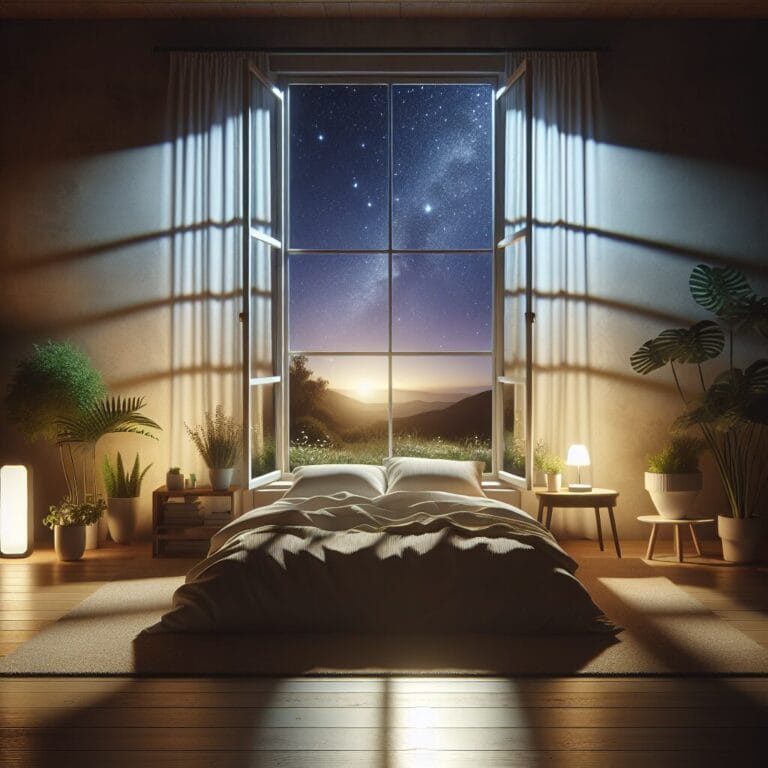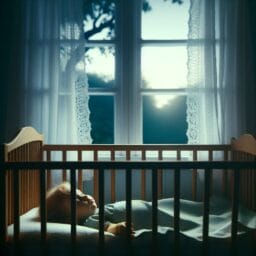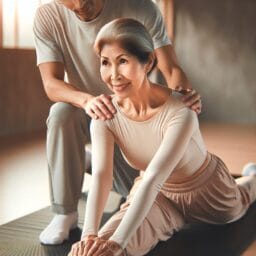
Nature’s Lullaby: Sleep Optimization Tips for Older Adults Embracing the Outdoors
Table of Contents
- Introduction
- Understanding Sleep Challenges in Older Adults
- The Healing Power of Nature
- Practical Sleep Optimization Tips for Older Adults
- Overcoming Barriers to Outdoor Activities
- Integrating Technology for Sleep Monitoring
- Conclusion
- Frequently Asked Questions
Introduction
Did you know that a gentle rustle of leaves or the soft chorus of crickets can lull our grandmas and grandpas into dreamland faster than you can say “sleepytime”? You see, for older adults who are often wrestling with pesky sleep disorders like sleep apnea or just plain old restless nights, Mother Nature might just be the best sleeping buddy they never knew they needed! Imagine this: instead of counting sheep, seniors can embrace the natural rhythms of our planet to help improve their sleep habits.
As we age, catching those Z’s gets trickier. Our internal clocks, known as circadian rhythms, can get all out of whack. But have no fear! The great outdoors is here to save bedtime. When seniors spend time in nature—be it pottering about in the garden or just basking in the afternoon sun—they’re actually giving their body cues to remember when it’s time to wake up and when it’s time to hit the hay. Cool, right?
Creating a sleep environment that’s buddies up with nature doesn’t have to mean moving into a treehouse (although, how fun would that be?). It could be as simple as keeping plants in the bedroom or using recordings of nature sounds to create a serene atmosphere. This bit of outdoor magic helps improve sleep patterns and quality sleep by telling that sleepy brain, “Hey buddy, it’s night-night time.”
And let’s not forget our homebound adults who can’t always step outside whenever they want. They too can join in on the fun by tuning into natural daylight patterns with special lamps or simply cracking open a window to let in fresh air. No more tossing and turning when nature is part of your nighttime posse!
So tonight, whether you’re young at heart or wise with years, consider inviting a slice of nature into your bedtime routine—it’s like a natural sleep aid without the need for any zzz-quilifying medication. And hey, jotting down these snooze-boosting adventures in a sleep diary wouldn’t hurt either; think of it as your personal guidebook for overcoming sleep problems on this wild journey called aging!

Understanding Sleep Challenges in Older Adults
Picture this: Grandma Mary, who’s always up with the sun and grandpa Joe, who snoozes like a log till noon—why are their sleep habits as different as night and day? Well, it turns out aging can shuffle our sleep patterns like a deck of cards. As folks sail into their silver years, those once predictable slumbers can start to zigzag, making quality sleep harder to catch than a runaway train in dreamland.
Now, let’s dive into the nitty-gritty. Sleep apnea is one sneaky cat burglar that often tiptoes into seniors’ lives, swiping away their breaths in the night and leaving them gasping for air. But it’s not only about catching breath; sleep disorders among older adults can also play spoilsport with their health big time—think mood swings dancing wildly or memories playing hide-and-seek!
So what’s the secret ingredient to improving sleep without gulping down handfuls of sleep medication? Drumroll please… nature! Those leafy greens and golden sunsets aren’t just easy on the eyes; they’re like nature’s very own sleep aid. By syncing with Mother Earth’s clock—the circadian rhythm—seniors can tweak their bedtime routine to embrace the yawns when darkness falls and spring out of bed when daylight calls.
Now before you think we need to pitch tents in the wilderness, hold your horses! Improving sleep starts right at home. Opening windows to invite in a breeze or adding plants that give off sleepy vibes can spruce up any bedroom into a snooze-friendly haven. And for our homebound adults tethered indoors? No sweat! The same magic works through sunlight-mimicking lamps that trick the body into thinking it’s basking under the sky.
Let me lay down some wisdom nuggets here—a well-kept sleep diary is like a treasure map leading straight to Slumberville for seniors exploring ways to overcome sleep problems. They jot down when they tuck in under stars or wake up with birds chirping outside, tracing patterns and tweaking habits till every night is just right.
And while we’re chatting about catching those precious Z’s, improving lifestyle choices such as slipping into comfy PJs or sipping on chamomile tea can be game-changers too. Put simply, caring for how one sleeps is just as crucial as what one eats or does during waking hours—it’s all about balancing life’s scales for those golden dreams.
So lean back, breathe deep, and watch how nature gently cradles our beloved older generation into peaceful slumber—it’s truly something beautiful worth turning over in bed for.

The Healing Power of Nature
Have you ever noticed the calming effect a walk in the park can have on your mind and body? Turns out, this isn’t just a fleeting feeling but a powerful tool that older adults can use to revolutionize their sleep habits. Stepping into nature is like pressing the refresh button on our internal computers, especially for seniors whose sleep patterns might be more erratic due to aging. This natural connection does wonders for resetting the circadian rhythm and guiding them gently towards more restful nights.
Studies suggest that exposure to natural light during the day boosts melatonin production as dusk falls, helping seniors fall asleep fast and soundly. It’s not just about sunlight though; incorporating elements such as plants known for their air-purifying and relaxing properties—think lavender or jasmine—into sleeping spaces can significantly improve sleep quality.
But what about those homebound adults who find themselves indoors more often than out? The answer lies in mimicking these outdoor experiences inside. An indoor fountain can recreate soothing water sounds while certain color palettes used in bedding or wall colors can emulate the hues of nature, promoting serenity and thus improving sleep.
Older individuals wrestling with sleep apnea or other disorders need environments that whisper, not shout, bedtime is near. So, setting up a sleep environment with shades of greens and blues reminiscent of forests and oceans could support deeper slumber without relying solely on sleep medication.
A tip straight from sleep gurus: keeping a ‘sleep diary’ might sound old school but it’s a practice ripe for revival among elders exploring ways to improve sleep habits. Noting down how natural elements influence their slumber time helps pinpoint what works best for each individual.
Here’s an intriguing fact—research indicates that even having images of landscapes in view can subconsciously connect an elder’s mind to tranquility, thereby paving the way for overcoming sleep problems associated with city living’s hustle-bustle.
So drawing from Mother Nature’s playbook could very well be the ticket to dreamland for older adults looking to improve their nocturnal journeys. Whether it’s planting seeds in pots by the window or tuning into simulation devices that mimic dawn and dusk—the goal is clear: aligning daily life with natural rhythms promises sweeter dreams and brighter mornings in our twilight years.
Practical Sleep Optimization Tips for Older Adults
As the sun peeks over the horizon, casting its golden glow on the world, it’s not just signaling a new day; it’s whispering a secret to better sleep for older adults. This sunrise spectacle taps into something ancient within us all—our circadian rhythm—and for seniors chasing those elusive zzzs, syncing their daily activities with daylight could be a game-changer. Did you know that timing outdoor activities like a morning stroll or light gardening can prime the body for restfulness come nightfall? Yes, indeed! By basking in the early rays and soaking up vitamin D, our elderly friends set their inner clocks ticking to nature’s perfect tempo.
Now let’s talk bedroom vibes—the kind that beckon sleep. Creating a sleep environment infused with nature isn’t about turning your home into a jungle (although that sounds pretty cool). It’s about simplicity and grounding: think cozy greens and earthy browns paired with bedding that feels like a cloud. How about accenting rooms with elements such as smooth river stones or gentle wind chimes that catch the breeze from an open window? These little whispers of nature indoors can comfort and cue older bodies that starry slumber time is near.
Then there are activities to tire out happy hearts so they can fall asleep fast at night—a jaunt around the garden or feeding chirpy birds can do wonders for sleep quality. But hey, what fuels those dreams better than winding down under an evening sky painted with sunset strokes? The answer is simple: pure delight derived from living harmoniously within Earth’s day-night dance.
For those seeking tranquility through mindfulness, imagine guiding our wise elders through relaxation techniques amidst greenery. Picture them practicing gentle yoga poses on fresh grass or meditating to trickling stream symphonies nearby. Such peaceful practices soothe minds stirred by life’s later chapters and lead gracefully towards sounder sleep patterns.
Let’s circle back to something impactful yet immensely personal—the humble sleep diary. As seniors scribble notes on how twilight colors affect their eyelids’ droopiness or how afternoon breezes usher in naps, they’re actually mapping out their unique path to improved sleep habits without popping any pills!
Isn’t it astounding how intertwining life’s daily rhythm with natural cues can uplift sleeping times for our cherished older generation? So here’s to longer days spent under open skies and cozier nights wrapped in Nature’s embrace, fostering sweet dreams and even sweeter awakenings for every grandparent out there. After all, Nature doesn’t just nurture—it heals, restores, and cradles us into blissful repose as only a mother knows how.
Overcoming Barriers to Outdoor Activities
Did you know that a splash of sunshine or a breath of fresh air is more than just pleasant? It’s actually a powerful boost for the sleep patterns of older adults! But let’s sprinkle in some practical magic so our seniors can safely soak up Mother Nature’s sleep potion. As we age, our bodies might not be as nimble, and safety becomes a major headline in the story of outdoor adventures. Here’s a sprinkle of wisdom: wearable tech like step-tracking wristbands isn’t just trendy; they’re perfect pals for monitoring activity without stepping over the line into tiredness.
Now, what if grandpa’s knees aren’t keen on long walks anymore? No problem! The beauty of nature is its versatility. Gardening can be tailored to any mobility level—raised flower beds for those who find bending troublesome or container gardening right on the porch for wheelchair-bound plant lovers. And remember, even watching birds flutter by from a cozy bench counts as connecting with nature. These gentler activities still sync folks up with that circadian rhythm everyone’s been chatting about.
But wait—what about when it’s drizzling or downright nippy outside? Should our dear seniors miss out on their dose of nature’s sleep remedy? Absolutely not! That’s where indoor-outdoor fusion comes into play. Encouraging older adults to sit by an open window with a cup of herbal tea lets them breathe in the benefits while staying snug and dry. On fair-weather days, layers are key—cozy hats and scarves help maintain body heat, making brisk walks invigorating rather than shiver-inducing.
So there you have it—a few tricks tucked in your pocket to help keep nights restful and nature-filled regardless of what life throws your way. Whether it’s sunny skies or grey clouds, improving sleep can still be natural and safe for all our cherished elders to enjoy every blissful snooze!
Integrating Technology for Sleep Monitoring
Have you ever marveled at how smartwatches and fitness bands seem to know so much about us? It’s like having a mini sleep scientist wrapped around your wrist, especially for older adults eager to catch some quality Z’s. These wearable sleep trackers are becoming the nightstand superheroes of our time, charting sleep patterns with precision and pinging gentle nudges that it’s time to wind down. For seniors looking to improve sleep habits without relying heavily on sleep medication, these gadgets are a godsend.
Let’s not forget the power of smartphones in this sleepy tech-tango. With a tap and swipe, aging adults can download apps designed specifically for sleep analysis. They’re like pocket-sized lullaby singers providing soothing nature sounds—from rainforests murmurs to ocean wave sonatas—that coax even the most stubborn eyelids to droop peacefully. Plus, they come packed with tips on creating a dreamy sleep environment that might just make counting sheep obsolete for those aiming to fall asleep fast!
But what about our homebound elders or those where aging affects mobility? This is where telemedicine swoops in! Imagine beaming up a sleep clinic right into your living room—no cape required! Telemedicine connects older adults with specialists who understand how vital quality sleep is and can offer remote guidance on managing any pesky sleep disorders from afar.
To sum up this snooze fest of innovation, whether we’re talking wearables that monitor restlessness or apps that fill our ears with whispers of wilderness at bedtime—technology offers endless possibilities for improving sleep among our respected seniors. And when they jot their progress down in a humble old-school sleep diary, they’re not just charting stars; they’re plotting constellations that lead the way to tranquil nights filled with sweet dreams powered by Mother Nature herself.
| Technology Type | Description | Benefits | Target Users |
|---|---|---|---|
| Wearable Sleep Trackers | Devices such as smartwatches and fitness bands that monitor sleep patterns. | Tracks sleep quality, provides reminders to sleep | Older adults interested in monitoring sleep habits without medication |
| Sleep Analysis Apps | Smartphone applications that offer sleep tracking and soothing sounds | Easy to use, offers sleep environment tips, plays relaxing sounds | Aging adults with smartphones seeking a better sleep environment |
| Telemedicine for Sleep | Remote consultation with sleep specialists | Accessible healthcare, professional advice for sleep management | Homebound elders, those with mobility issues |
| Sleep Diaries | Traditional method of recording sleep patterns and habits | Personal tracking, encourages mindfulness regarding sleep | Seniors who prefer a hands-on approach to sleep monitoring |
Conclusion
Stepping outside on a crisp, clear morning, have you ever felt your senses perk up as if the fresh air were whispering secrets of vitality right into your soul? This isn’t just whimsy; there’s science behind it. The great outdoors is a veritable symphony of subtle cues that help older adults sync their internal rhythms with the world around them. Imagine this: as the evening sky dons its twilight hues, it beckons seniors to begin their bedtime routines, setting the stage for a night of rejuvenating sleep.
For homebound adults or those navigating sleep disorders like sleep apnea, even small interactions with nature can wield significant benefits for sleep quality. Think about creating a space where indoor meets outdoor—a plant-filled nook or nature sounds playing softly in the background—each serving as a gentle reminder of the natural world’s rhythm and promoting an environment conducive to quality sleep.
Ever considered how a well-timed cup of herbal tea basking in afternoon sunbeams could better prepare an elder for rest? Sipping slowly as daylight wanes helps align one’s circadian rhythm with nature’s clock—a powerful sleep aid without turning to medication. And what about gardening? Not only does it give rise to blooms, but also blooms restful nights by engaging seniors in physical activity that tires out their bodies just enough to fall asleep fast when they nestle into bed.
In essence, every leaf rustling in the wind and each bird call as dusk falls are parts of Mother Nature’s lullaby for our elders—tools at their disposal to improve sleep habits naturally. As seniors chronicle these experiences in their sleep diaries, they’re not just tracking patterns; they’re tailoring personalized blueprints for overcoming sleep problems that harness nature’s healing touch.
So let us hold dear this revelation: intertwining outdoor moments into daily life isn’t merely pleasant—it’s practical magic for enhancing the slumber of older adults. Here’s an invitation to all wise souls who’ve seen countless moons: let nature tuck you in tonight and wake you refreshed come morning light.



